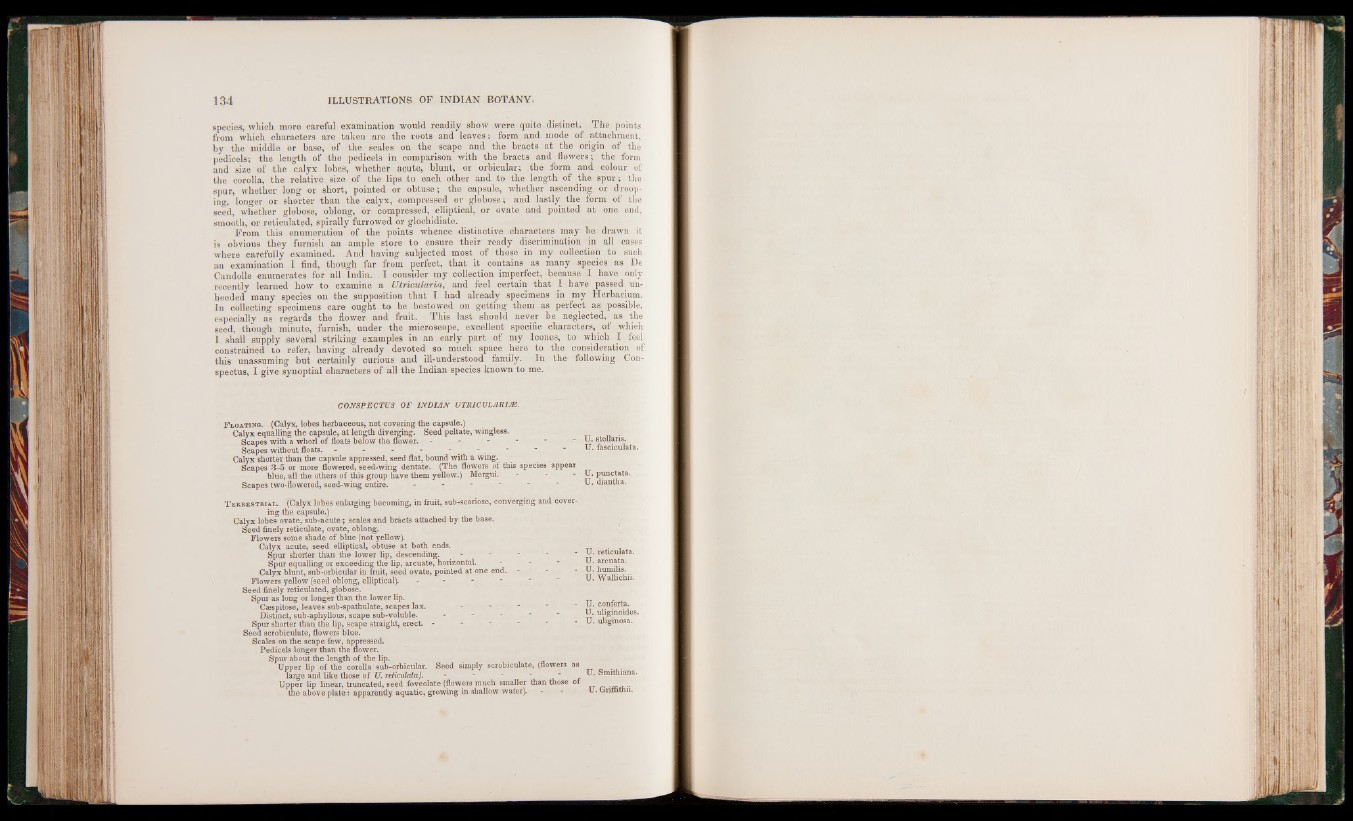
species, which more careful examination would readily show were quite distinct. The points
from which characters are taken are the roots and leaves; form and mode of attachment,
by the middle or base, of the scales on the scape and the bracts at the origin of the
pedicels; the length of the pedicels in comparison with the bracts and flowers; the form
and size of the calyx lobes, whether acute, blunt, or orbicular; the form and colour of
the corolla, the relative size of the lips to each other and to the length of the spur; the
spur, whether long or short, pointed or obtuse; the capsule, whether ascending or drooping,
longer or shorter than the calyx, compressed or globose; and lastly the form of the
seed, whether globose, oblong, or compressed, elliptical, or ovate and pointed at one end,
smooth, or reticulated, spirally furrowed or glochidiate.
From this enumeration of the points whence distinctive characters may be drawn it
is obvious they furnish an ample store to ensure their ready discrimination in all cases
where carefully examined. And having subjected most of those in my collection to such
an examination I find, though far from perfect, that it contains as many species as De
Candolle enumerates for all India. I consider my collection imperfect, because I have only
recently learned how to examine a Utricularia, and feel certain that I have passed unheeded
many species on the supposition that I had already specimens in my Herbarium.
In collecting specimens care ought to be bestowed on getting them as perfect as possible,
especially as regards the flower and fruit. This last should never be neglected, as the
seed, though minute, furnish, under the microscope, excellent specific characters, of which
I shall supply several striking examples in an early part of my leones, to which I feel
constrained to refer, having already devoted so much space here to the consideration of
this unassuming but certainly curious and ill-understood family. In the following Conspectus,
I give synoptial characters of all the Indian species known to me.
CONSPECTUS OF INDIAN UTRICULARIA.
Floating. (Calyx, lobes herbaceous, not covering the capsule.)
Calyx equalling die capsule, at length diverging. Seed peltate, wingless.
Scapes with a whorl of floats below the flower. - - - - - - U. stellans.
Scapes without floats. - - - - - " - U . fasciculata.
Calyx shorter than the capsule appressed, seed flat, bound with a wing.
Scapes 3-5 or more flowered, seed-wing dentate. (The flowers of this species appear
blue, all the others of this group have them yellow.) Mergui. - - - U. punctata.
Scapes two-flowered, seed-wing entire. - - - - - - U. diantha.
Terrestrial. (Calyx lobes enlarging becoming, in fruit, sub-scariose, converging and covering
the capsule.)
Calyx lobes ovate, sub-acute; scales and bracts attached by the base.
Seed finely reticulate, ovate, oblong.
Flowers some shade of blue (not yellow).
Calyx acute, seed elliptical, obtuse at both ends.
Spur shorter than the lower lip, descending. -
Spur equalling or exceeding the lip, arcuate, horizontal.
Calyx blunt, sub-orbicular in fruit, seed ovate, pointed at one end. -
Flowers yellow (seed oblong, elliptical). -
Seed finely reticulated, globose.
Spur as long or longer than the lower lip.
Caespitose, leaves sub-spathulate, scapes lax.
Distinct, sub-aphyllous, scape sub-voluble. -
Spur shorter than the lip, scape straight, erect - - - -
Seed scrobiculate, flowers blue.
Scales on the scape few, appressed.
Pedicels longer than the flower.
Spur about the length of the lip. .
- U. reticulata.
U. arcuata.
- U. humilis.
U. Wallichii.
U. conferta.
U. uliginoides.
U. uliginosa.
Upper lip of the corolla sub-orbicular. Seed simply scrobiculate, (flowers as |
large and like those of U. reticulata). - - - " „ U. Smithiana.
Upper lip linear, truncated, seed foveolate (flowers much smaller than those of
the above p late: apparently aquatic, growing in shallow water). - - U. Gnintmi.